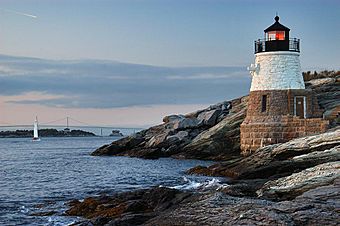Ocean Drive Historic District facts for kids
|
Ocean Drive Historic District
|
|

View of Castle Hill Light, located at the end of the Ocean Drive
|
|
| Location | Newport, RI |
|---|---|
| Area | 1,509 acres (611 ha) |
| Built | Late 18th-20th century |
| Architectural style | Late Victorian, early 20th-century revival styles |
| NRHP reference No. | 76000048 |
Quick facts for kids Significant dates |
|
| Added to NRHP | May 11, 1976 |
| Designated NHLD | May 11, 1976 |
The Ocean Drive Historic District is a special area in Newport, Rhode Island. It covers a long road called Ocean Drive, which runs along the southern coast of Newport. This area was named a National Historic Landmark District in 1976. This means it's a very important place in American history.
It's known for its beautiful landscape and unique buildings. The design of the area was partly done by Frederick Law Olmsted, a famous landscape architect. The houses here are usually less fancy and showy than the huge summer homes found on nearby Bellevue Avenue. Many of these houses are built on large pieces of land and have amazing views of the beaches and the ocean. In the late 1800s and early 1900s, wealthy people who owned mansions on Bellevue Avenue loved to come here for picnics.
Contents
What is the Ocean Drive Historic District Like?
Ocean Drive starts near the end of Bellevue Avenue. It follows the coastline closely, winding its way generally from east to west. The road goes all the way to Brenton Point State Park, which is at the southwestern tip of Aquidneck Island. This is the only spot where the road turns away from the shore. After that, it continues along the coast, offering views towards Conanicut Island, before it finally ends just south of Fort Adams.
What Does the Land Look Like?
The land along Ocean Drive mostly has sand dunes and small hills. Many houses were built on these hills, showing different styles from the late 1800s and 1900s. The hills are mostly open, with some small bushes and groups of trees. Most of the land here is used for homes.
Out of the 53 buildings in the district, only a few are for businesses. These are mainly clubhouses for private beaches and other small buildings that go with them. One beach, called Gooseberry Beach, is open to everyone. Unlike other historic areas in Newport, none of the buildings in the Ocean Drive Historic District are listed separately on the National Register of Historic Places.
When Did Ocean Drive Become Important?
The area around Ocean Drive used to be farmland, far away from the main part of Newport during the time of the American colonies. As Newport grew and wealthy summer visitors built bigger and grander mansions along Bellevue Avenue, the Ocean Drive area also started to be developed.
However, because the land here was more hilly, smaller houses were built. This is why the area still feels a bit like it did a long time ago, keeping some of its original charm.
How is the Historic District Protected?
To make sure the Ocean Drive Historic District keeps its historic look, the city of Newport created the Historic District Commission (HDC) at the same time the district was formed. This commission is made up of nine citizens. They are chosen by the City Council to serve for three years.
The HDC helps to protect not only the Ocean Drive area but also Newport's other historic districts. Two of these, downtown Newport and Bellevue Avenue, are also very important and recognized as National Historic Landmarks. For managing these areas, the city treats all of them as one big historic district.
What Does the Commission Do?
If someone wants to make changes to the outside of a building in the district, beyond normal repairs, they must get approval from the HDC. The commission reviews the plans and then decides if the changes fit the historic character of the area. If they approve, they issue a "Certificate of Appropriateness." However, the HDC cannot force property owners to make any changes to their buildings.
Images for kids




